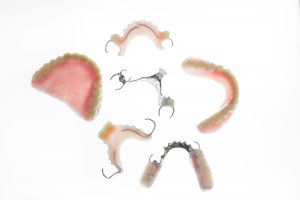Are you concerned about your missing teeth? Not having a full set of teeth can cause problems with eating, speaking and appearance – to mention just a few – so it's good to consider the options for replacing missing teeth.

You're certainly not alone with this problem, though. Studies show that adults in England are missing almost 7 teeth on average, and only 8% have a full set of 32 teeth (including wisdom teeth).
There are several solutions that can replace a missing tooth, but each has its own pros and cons. You'll need to consider what's most important in terms of:
- Cost
- Aesthetics
- Durability
- Comfort
- Convenience
In this guide, we'll explain the different restoration options so you can decide which is best for you whether you're missing a front tooth, back tooth, or several teeth.
In This Article
Is it necessary to replace a missing tooth?
If you or someone you know are missing one or more of your teeth, you probably already understand some of the problems that missing teeth can cause, including difficulty aesthetics and function.
- Difficulty eating certain foods
- Self-consciousness over appearance, especially with a missing front tooth
- Increased risk of chipping or cracking surrounding teeth
- Speech problems
- Other teeth becoming crooked
- Greater likelihood of gum disease and cavities
- Deterioration of the jawbone, which can make the face sag over time (worse when several teeth are missing)
It’s a cosmetic disaster and the root of some unpleasant stereotypes, but the health effects of missing teeth are numerous and potentially serious. People risk increased damage to surrounding teeth, gum disease, cavities, the deterioration of the jawbone and even malnutrition:
- The mouth is a critical part of the digestive process.
- When a person can’t properly chew their food they are seriously taxing their gastrointestinal system.
- Acid reflux and a host of other digestive issues can erupt.
- For every five teeth lost, a person is nearly one and a half times more likely to demonstrate decreased intake of vital nutrients that can lead to malnourishment.
Dr. Hunter Dawson, Carolinas Center for Oral, Facial, Cosmetic & Dental Implant Surgery
If you are missing a back tooth which isn't really visible, you might not feel like it's a big issue. However, the longer you have gaps in your mouth from missing teeth, the more it is likely to have negative consequences on your oral health. So even if you don't notice any immediate problems, it's worth considering your replacement teeth options to protect your mouth from damage later on.
The following animation demonstrates how not treating a single missing tooth can affect other healthy teeth:
Reasons for missing teeth
Missing adult teeth can occur for a number of reasons. It might be an accident or injury which knocked out a tooth or damaged it beyond repair. Tooth decay and gum disease may also advance to the point where teeth fall out or have to be extracted.
And did you know it's possible to have teeth missing because of a genetic condition called hypodontia? Also known as ‘congenitally missing teeth', hypodontia causes one or more of the 20 baby teeth or 32 adult teeth to be absent.
It's often the wisdom teeth which are affected by hypodontia, in which case missing tooth replacement isn't necessary. But between 1.6% and 6.9% of the population are missing one or more of their other adult teeth, often the second premolar or lateral incisor, which can cause problems if they are not replaced.
Treatments for replacing missing teeth
Now let's take a look at the various treatment options for missing teeth:
- Teeth implants
- Bridges
- Dentures
- Veneers (in some cases)
- Braces
If several teeth are missing in different positions, a combination of these treatments may be the optimal solution.
If you’re missing teeth, it can make it difficult to chew and talk each day, along with really affecting your self confidence. However, you have options for replacing missing teeth. Common options include:
- Implant restorations: this option is best for people who are missing teeth due to injury, gum disease, or any other reason. An implant is a metal post that is surgically positioned into the jaw to replace the root of a lost tooth.
- Partial dentures: these are used when some natural teeth remain.
- Full dentures: for if you have to replace all of the teeth in one or both arches (upper and lower).
- Implant retained dentures: unlike conventional dentures, these partials are anchored to fixed titanium posts embedded in the jawbone that mimic natural tooth roots.
Dr. Ashley Niles, Niles Family Dentistry
Dental implants
Implants are the replacement tooth option that's closest to a real tooth. This is because the metal implant is inserted into the jaw bone, performing some of the same functions as a tooth root. Importantly, it fuses with the jaw bone to prevent bone loss and changes to the shape of the face.
An implant can support a single tooth crown, or two implants can support a bridge of 3-4 teeth. This is the most expensive option for replacing missing teeth, but it's also very long-lasting. Implants should look and feel like normal teeth once they are in place. You'll need to take care of them with proper brushing and flossing, but there is no special cleaning required.
Read all about teeth implants in our separate guide, or use our price calculator below to see how much your treatment could cost.
Coût total estimé
All-on-4 implants for replacing all teeth
If you're missing all the teeth in one or both jaws, or if any remaining teeth are in poor condition, All-on-4 implants are a more affordable alternative to traditional implants. Using just four or six implants in each jaw, a full set of replacement teeth can be attached (know as implant dentures).
If you're missing all your teeth, this option is more expensive than dentures but it also much longer-lasting and should let you eat like normal.
Dental implants look and function just like natural teeth and are the only type of replacement teeth that are embedded into the jaw bone. These artificial tooth roots stimulate the jaw bone the same way natural tooth roots do which keeps the bone healthy. This solid foundation enables the implant to function like a healthy tooth while remaining securely in place.
It’s also important to keep in mind that a dental implant is a complete restoration. There is no special dental care necessary – just brush and floss like you always do – and the implant’s foundation will allow you to enjoy your favourite foods without worry. The crown is also designed to match the shape and colour of your other teeth for beautifully natural-looking results. With proper care, your implant can last a lifetime.
Dr Sukhdeep Dhaliwal, DDS, MD, FACS – Kitsap Oral, Maxillofacial & Dental Implant Surgery
Dental bridge
A dental bridge is a kind of fake tooth that's supported by the neighbouring healthy teeth, like 3 (or 4) crowns joined together. The supporting teeth have to be filed down slightly for the bridge to fit over the top, then it's secured with an adhesive.
It's also possible to get a bonded bridge with ‘wings' that fix to the adjacent teeth – this is preferable if the teeth are in good condition and you want to avoid removing healthy enamel.
Bridges are a good balance between price and durability, and they should look like natural teeth. A bridge can only replace up to two missing teeth at a time, so if you're missing several in a row then you'll need to consider another option.
See our dental bridge guide for more information about this treatment. You can also learn about the pros and cons when it comes to dental bridge vs implant treatment.
Dentures

Dentures are usually the cheapest way to replace a missing tooth or even a full mouth of teeth. Also called “false teeth”, they are removable appliances with any number of fake teeth attached to a wire and acrylic frame. Partial dentures are used when you're not missing all of your teeth.
Some people live very happily with dentures, but others find them uncomfortable and have problems with them slipping out of place. You might therefore opt for temporary dentures as an intermediate treatment option while saving money for a more permanent solution.
You can also consider premium flexible dentures for greater comfort. One of the most well known and popular types of flexible dentures is Valplast partial dentures which you can read about in our full guide.
Veneers
Occasionally it's possible to use veneers for missing teeth, but only if there is a very small gap left between two teeth. A veneer, either composite or porcelain, is applied to the teeth either side to “fill in” the gap. In most cases, this is not a recommended missing tooth replacement option.
You might also consider snap-on veneers like instasmile, which clip onto the existing teeth and cover all the teeth in one arch. They are a quick and relatively inexpensive way to hide a missing tooth, but we don't recommend them as a long-term solution. They won't stop bone loss occurring and there is a risk of damaging the healthy teeth while wearing them.
Braces
Treatment to replace a missing tooth may also involve orthodontic work. If you have had teeth missing for a while, the other teeth may have started to move out of alignment and develop a bad bite. Braces can bring the remaining teeth back into their proper position before replacing the missing teeth.
This may be an optional part of your treatment, but bear in mind that having straight teeth is not just about aesthetics; it also makes it easier to maintain good oral hygiene. Your dentist will be able to explain your treatment options and outcomes.
What does replacing missing teeth cost?
In the table below you can see a summary of the missing teeth treatment options discussed above, as well as approximate costs for replacing missing teeth in these ways:
[wptb id="31158" not found ]Tooth replacement options on the NHS
Dentures and bridges are both covered by the NHS band 3 treatment charge, which is £282.80 for 2020/21. If your NHS dentist agrees that you need one of these treatments, you'll only pay the charge once for the entire treatment course, even if you need other work like extractions or fillings.
It is possible to get dental implants on the NHS, but only in very specific circumstances. If it's just a matter of personal preference, you'll have to fund them privately, unless you get lucky with free implant treatment at a dental school or elsewhere.
How to replace a missing tooth cheap
If you're on a tight budget but don't want removable dentures, there are other ways to make dental implants more affordable.
One popular option is to travel abroad to a country like Hungary or Turkey where high-quality dental care is much cheaper than in the UK. Patients can save 50-70% on their dental costs this way. To see if this would be a good missing tooth option for you, check out our guide to getting dental implants abroad or request a free quote from our recommended dental tourism service, Dentaly Go.
We also have a separate guide with some tips for finding cheap dental implants and lowering the cost of your treatment.
Best options for missing teeth
Replacing a single tooth

If you can afford it, a dental implant is a natural-looking and long-lasting way to replace a single tooth without affecting either of the neighbouring teeth.
However, both dentures and bridges are suitable ways to replace a single missing tooth as well. They may not last as long as an implant, but they are more affordable – you'll probably find that dentures cost less in the UK than any other option.
Multiple teeth missing
Dentures are the cheapest way to replace multiple missing teeth. Even if you only have a handful of healthy teeth remaining (or none at all), a removable denture can fill in the gaps and let you eat and speak like normal.
An implant bridge can be used for 3-4 teeth in a row, while full mouth implants provide a full jaw of replacement teeth.
Missing front tooth vs. missing back tooth replacement
If you have a missing front tooth, aesthetics become a more important factor when choosing your treatment. Ceramic bridges and implants, when made well, can blend with your natural teeth. Acrylic dentures don't look quite so natural. It's possible to get ceramic dentures, but this increases the price significantly.
Another issue with dentures is that some metal wire clips may be visible, depending on the design. So the best option for missing front teeth is implants or a bridge, in terms of aesthetics.
Conclusion
There are several ways to replace missing teeth and we hope this guide has helped you work out which option would suit you best.
One thing we don't recommend is doing nothing. Even if having a tooth missing isn't bothering you now, leaving the gap in your mouth could lead to more problems in the years to come. Your dentist will be happy to discuss all the dental options for missing teeth with you.





